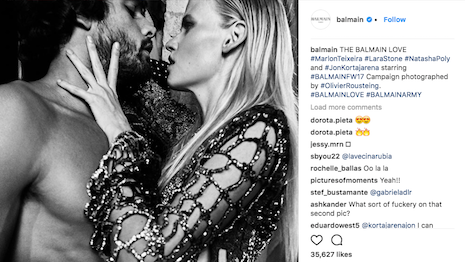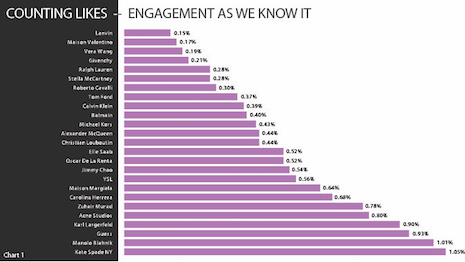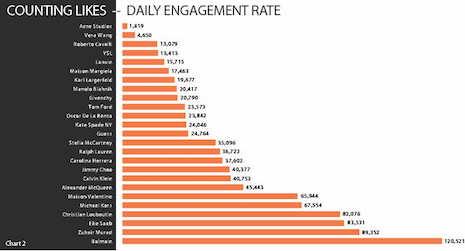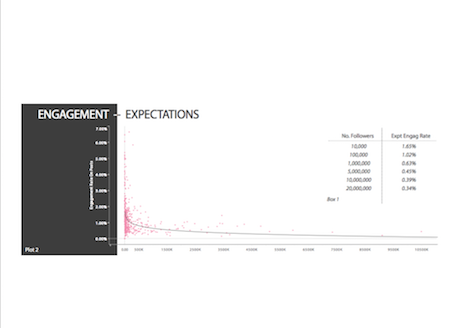- About
- Subscribe Now
- New York,
February 20, 2018

 Balmain shows love for Instagram. Image credits: Balmain and Instagram
Balmain shows love for Instagram. Image credits: Balmain and Instagram
By Jack Hesketh
Engagement is at the very heart of social network design and purpose. It is all about communication on a personal level. On Instagram engagement levels tell us how much a brand’s audience actively consumes the content that they post, giving us a strong indication of a brands influence over their followership.
With an incredible 96 percent of United States fashion brands now present on Instagram, there is a growing need to understand what the numbers really mean.
Here we question how we look at engagement, and what it actually means for brands. Perhaps this will reshape how you understand and measure brand activity, and more generally how brands are perceived by their audience on Instagram.
We analyzed 25 top luxury fashion brands, each with between 1.5 million and 10.5 million followers, and ranked them based on their engagement using two different methods: engagement rate and daily engagements.
Kate Spade New York tops our engagement ranking, but as you will see this does not tell the whole story. We demonstrate that your perception of a brand and their perceived popularity on Instagram does not always hold true.
Your impression of a brand and their perceived popularity does not always hold true.
Counting Likes: Engagement as we know it
Kate Spade New York tops our list as the brand with the highest engagement rate on each post, scoring 1.05 percent.
Meanwhile Lanvin come in last, at number 25, with an engagement rate of just 0.15 percent. That is 7x less engagement than is achieved by Kate Spade New York.
Despite all 25 brands being internationally recognized, many of them clock engagement rates a lot lower than you might expect. This underperforming group includes brands such as Ralph Lauren, Stella McCartney and Givenchy, all of which record engagement rates of less than 0.3 percent, way behind the average score of 0.52 percent across our 25 brands.
So is that it? Kate Spade wins, Lanvin loses. Not exactly. To get to the bottom of engagement, we need to look a little closer.
We can also look at engagement from a different angle. Instead of measuring “likes per post,” we can look at the number of “likes per day.” We can call this the daily engagement rate.
 Counting Likes: Engagement as we know it
Counting Likes: Engagement as we know it
Counting Likes: Daily engagement
Balmain gets more likes per day than Acne studios, Vera Wang, Roberto Cavalli, YSL, Lanvin, Maison Margiela, Karl Lagerfeld and Manolo Blahnik, all together.
This time, we have a new order. Suddenly Kate Spade does not top the list. Instead, Balmain is streaking ahead with more than 120,000 likes each day, 30,000 more than the next most engaged brand, Zuhair Murad (89,352).
What is even more surprising is that this level of engagement is higher than that achieved by the bottom eight brands combined.
Balmain gets more likes per day than Acne studios, Vera Wang, Roberto Cavalli, YSL, Lanvin, Maison Margiela, Karl Lagerfeld, and Manolo Blahnik, all together.
Perhaps more remarkable is the way that some brands are underperforming.
Acne Studios fails to get more than 2000 likes each day. And we can see exactly why: it hardly ever posts. At a rate of one new post every nine days, it is no wonder the brand is struggling here.
Conversely, Balmain, our champion of engagement, posts more than anyone else. At a rate of four posts each day, you might think it is bullying its way to the top by posting all the time? But it is not that simple.
 Counting Likes: Daily engagement rate
Counting Likes: Daily engagement rate
Posting a lot does not punish your engagement rate. Poor content and bad strategy is what punishes your engagement rate.
Here we see that the more often a brand posts, the less engagement it receives for each post. However, the important thing to note is that engagement drops off very gradually, so posting frequently does not punish a brand like you might think?
Balmain strikes a fine balance between its engagement rate (0.4 percent), and the number of times it posts each day. Its effort to post frequently and engage their audience with good content is most evident when you compare them with Maison Valentino.
Both brands, Maison Valentino and Balmain post with exactly the same frequency, whilst Maison Valentino has the advantage of 2.2 million additional followers. And yet, it only achieves 66,000 likes per day, almost half the number received by Balmain. In other words people really do ‘Like’ Balmain’s content a lot more.
Of course, Instagram is not all about numbers, there is a limitless subjective component, and here is where Balmain separates itself from Maison Valentino.
As far as haute couture brands go, look no further than Balmain as an example of a beautifully curated profile on Instagram. It features almost no atypical product shots, and frequently includes images of A-list celebrities supporting its products, such as Naomi Campbell, Rihanna, Claudia Schiffer and the Kardashians, to name a few.
What is more, Balmain’s images are posted in clear thematic groups around specific periods of time: Nov. 25 – #ForeverIconic, Nov. 27 – #ArmyOfAngels, Nov. 28 – #FromPinkToPunk. This is no coincidence. This is an Instagram strategy executed properly.
For a luxury brand of this type, Balmain does a fantastic job to promote itself through Instagram. And yet its engagement rate as measured per image (0.40 percent) would suggest otherwise.
Conversely, Acne Studios scores a very respectable engagement rate as measured per image (0.80 percent). However, the brand fails to engage more than 2,000 users each day, which for a brand with more than 2 million followers, this is underperformance at its most extreme on Instagram. It is not surprising then that its Instagram profile is disorganized and littered with unimaginative product and catwalk shots.
What is more, Acne Studios follows absolutely nobody, suggesting a total refusal to engage with the network as a whole, and hence this could be why it receives so little engagement in return.
Expectations of Instagram engagement rates for brands too high. Need a rethink
Here we show that brand engagement levels on Instagram are simply not as buoyant as you might think.
Across all 25 brands we find an average engagement rate of just 0.52 percent on each post. The fact is, they just do not get that much engagement.
Even when we analyze our brands from the angle of daily engagements, where we account for brands posting multiple times each day, we find that our brands still only manage to engage 0.75 percent of their followership every 24 hours.
These numbers might be surprisingly low to many readers, but it demonstrates the importance of context.
Put simply, for big brands, which exceed 1.5 million followers, here we suggest that receiving a like from 0.52 percent of your followership is in actually a very respectable engagement rate for a single post.
Based on the data we have collected here from 25 top brands, even Kate Spade with our highest engagement rate per post only just about manages to surpass an engagement rate of 1 percent on each post.
In reality, our expectations of brand engagement must take into account the size of a brands followership.
Put simply, the bigger the followership, the harder it is to engage your audience. This is nothing new, but from a marketing perspective we have to avoid putting all brands into the same group.
Instead, we should measure their success on Instagram against the visible patterns of social network, as opposed to our own preconceived and sometimes misguided ideas.
 Engagement versus expectations
Engagement versus expectations
Data that we have gathered from a much larger study across 500 brands can be used to make predictions as to how much engagement brands receive relative to the size of their followership. Here we display this exact relationship (plot 2), and some examples of the exact engagement rates that we expect from brands with distinct followership sizes (box 1).
Take-home messages
1. Engagement rates on their own can be very misleading. When measuring a brands engagement on Instagram we need look at post frequency to get the full picture.
2. Posting a lot will not punish your brands engagement levels. If a brand posts great content in line with their image, then they can post almost as much as they like.
3. Our expectations are just too high. Our overall expectation of engagement rates for really big brands should be revised down.
Something extra
Our findings pose an important question: Why are these top brands failing to reach the highest levels of engagement? Here we provide three explanations, which are not mutually exclusive.
1. Instagram was never meant for brands: Instagram started off as a network for people to share images with other people.
At its core, there is an essential human element. Most of us spend our days interacting with other humans on some level, so it is completely natural. We do not, however, typically interact with brands, and hence it is important to remember that brands have been shoehorned into a social network for people.
It is impossible for someone to know more than 1,000 people, let alone 1 million. Brands do not look or act like people within the network, so they will be treated as such.
2. People do not treat big brands like smaller brands: With social media channels there is the idea that we can communicate with just about anyone on the network, and that this communication should be a two-way street.
The problem is, the bigger a brand’s followership becomes, the less it appears like a “normal user,” and as such it is treated differently.
Research suggests that users are less inclined to interact with other users who have very large followerships, and this, of course, includes big brands (REF). They appear less “normal” and therefore do not quite fit into the social structure of the network.
3. Big brands are well known, but not well followed: Perhaps the Achilles’ heel for big well-known brands is that they have never needed to grow their image through the Instagram network. They have acquired many followers due to recognition that precedes Instagram, as opposed to gaining followers because of the content they actually post on Instagram.
As a result, their role on the network is typically more passive. They never really needed to work for their followership, so they do not work to maintain it either.
 Jack Hesketh
Jack Hesketh
Jack Hesketh runs product development and marketing at Photoslurp, Barcelona, Spain. Reach him at jack@photoslurp.com.
Share your thoughts. Click here